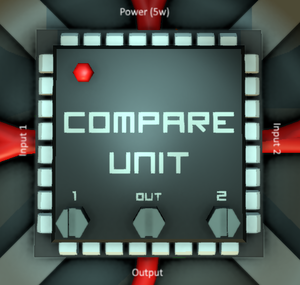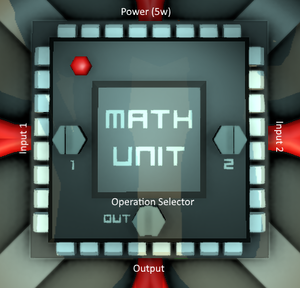Difference between revisions of "Carsten Milkau/NOT Gate"
From Unofficial Stationeers Wiki
< User:Carsten Milkau
(→Definition: names x and y for inputs/outputs in truth table) |
(→Implementation) |
||
| Line 26: | Line 26: | ||
NOT gates can often be avoided by modifying the circuit. For instance, an [[User:Carsten Milkau/OR Gate|OR Gate]] with two NOT gates connected to its inputs and outputs can always be replaced by an AND gate with just one NOT gate connected. | NOT gates can often be avoided by modifying the circuit. For instance, an [[User:Carsten Milkau/OR Gate|OR Gate]] with two NOT gates connected to its inputs and outputs can always be replaced by an AND gate with just one NOT gate connected. | ||
| − | + | === Single Block === | |
| + | |||
| + | [[File:CompareUnit.png|thumb]] | ||
| + | |||
| + | Use the Gate Unit, set it to Nor and both inputs to the same Logic Reader. | ||
=== Using A Less-Than Comparator === | === Using A Less-Than Comparator === | ||
Latest revision as of 22:00, 14 July 2023
Contents
NOT Gate[edit]
A NOT gate, sometimes also called inverter, is a circuit that outputs the value that was not input. It has a single input and output, and each can only take one of two pre-defined values (typically 0 and 1). Whatever the input value is selected, the output value will be the other of the two.
Definition[edit]
| inputs | outputs |
|---|---|
| x | y |
| 0 | 1 |
| 1 | 0 |
Connectors[edit]
- Input x: one of two values (0 or 1)
- Output y: the other of the two values
Implementation[edit]
NOT gates can often be avoided by modifying the circuit. For instance, an OR Gate with two NOT gates connected to its inputs and outputs can always be replaced by an AND gate with just one NOT gate connected.
Single Block[edit]
Use the Gate Unit, set it to Nor and both inputs to the same Logic Reader.
Using A Less-Than Comparator[edit]
If you have a circuit available (e.g. a constant memory) that has a value b known to stay between 0 and 1 (but not 0), you can turn a Compare Unit into a logic NOT gate by comparing the input x to b, i.e.
y = (x < b)
| unit | unit type | connector/setting | source / value |
|---|---|---|---|
| compare 1 | Compare Unit | Input 1 | x (input) |
| Input 2 | b (constant or bounded value) | ||
| Operation Selector | Lesser | ||
| Output | y (output) |
Using An Equality Comparator[edit]
If you have a circuit output available that is known to be zero when the NOT gate is used (e.g. a constant memory), you can turn a Compare Unit into a logic NOT gate by comparing the input x to 0, i.e.
y = (x = 0)
| unit | unit type | connector/setting | source / value |
|---|---|---|---|
| compare 1 | Compare Unit | Input 1 | x (input) |
| Input 2 | 0 (constant) | ||
| Operation Selector | Equals | ||
| Output | y (output) |
Using Subtraction[edit]
If you do not use 0 and 1 as the two possible input values of the inverter, you can use subtraction for implementation. In this case, you need a constant that is exactly the mean of the two input values, i.e.
y = (m - x)
where m = (a + b)/2 is the mean of the two allowed input values, (called a and b here).
| unit | unit type | connector/setting | source/value |
|---|---|---|---|
| math 1 | Math Unit | Input 1 | x (input) |
| Input 2 | m (constant, see above) | ||
| Operation | Subtract | ||
| Output | y (output) |


